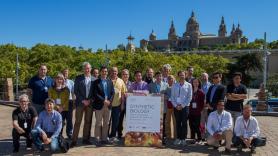2. Towards the creation of artificial life
In 2010, a study conducted at the J. Craig Venter Institute made its way around the world: they had synthesized a living being for the first time. According to J. Craig Venter, it was “the first cell whose mother was a computer.” However, for Jane Calvert, reader in Science, Technology and Innovation Studies at the University of Edinburgh, “what Venter proposed was copying, not designing an organism.” They copied the DNA of the Mycoplasma mycoides bacteria letter by letter (approximately one million) and then put it into another, very similar one.
First artificial life?
After the study conducted at the J. Craig Venter Institute that synthesized a living being in 2010, the media heralded the discovery as the first time artificial life had been created. But the idea wasn’t new: according to Juli Peretó, researcher at the Evolutionary Biology Institute at the University of Valencia, the first one goes back to 1899, when Jacques Loeb proposed what is called artificial parthenogenesis.
A new project proposes going further, synthesizing a more complex genome: that of a yeast (used to make bread or even beer). Plus, scientists are also modifying the genome as they manufacture it: adding, for example, sequences to cut and paste DNA when the estradiol hormone is present, which would allow them to study new combinations. “It isn’t exactly a yeast,” explains Calvert, “It will be a yeast-like organism.”
Both of these projects require a mold: an organism to house the DNA. Plus, particularly the second, they have a top-down approach: they take the full information and play with it to understand and take advantage. But there is another possible approach, making life forms without any pattern: from the bottom up. There is no clear consensus about what constitutes life. Not even “minimum life”. For Steen Rasmussen, director of the Center for Fundamental Living Technology in Denmark, this implies a system that is able to transform resources from its environment in order to form, grow and divide, and that can evolve. In his laboratory, they have “created” some of these conditions. His idea consists in synthetic DNA molecules and a series of light-sensitive compounds “stuck” to oil droplets. When they are exposed to light, these “protocells” can interact with their environment and, through rudimentary metabolism, produce small products that join onto the droplets to make them grow. Later, they divide as they get bigger, creating similar “daughter cells”.
“It’s a conceptual approximation,” says García-Ojalvo, “in which the cell acts not as a container, but as a substrate for life. Although it doesn’t have a direct application, studies like these are very interesting, among other reasons, because we don’t know what life could be like in other places.”



